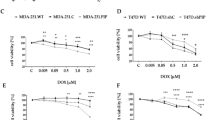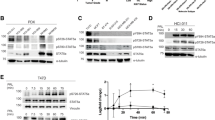Abstract
The involvement of human prolactin (hPRL) in breast cancer has been recently reconsidered based on its autocrine/paracrine proliferative effect described in human mammary tumor epithelial cells. Therefore, there is growing interest in the development of potent hPRL antagonists that may inhibit this effect. We previously designed hPRL analogs displaying antagonistic properties in a human transcriptional bioassay. We now report that the most potent of those analogs, G129R-hPRL, antagonizes all hPRL-induced effects analysed in various breast cancer cell lines, including cell proliferation. The analog per se lacks intrinsic agonistic activity on PRL receptor-activated signaling cascades, cell proliferation and apoptosis, indicating that its mode of action only occurs through competitive inhibition of hPRL. We provide some molecular basis of this antagonistic effect by demonstrating that G129R-hPRL competitively inhibits hPRL-activation of the JAK-STAT and MAPK pathways, two signaling cascades involved in the mitogenic effect of hPRL in mammary epithelial cells. This competitive inhibition persists for at least 48 h, as evidenced by long term analysis of STAT5b activation or of progression through cell cycle. These results are the first demonstration at the molecular level that hPRL antagonists interfering with receptor dimerization disrupt signaling events in breast cancer cells, which prevents hPRL-induced cell proliferation.
This is a preview of subscription content, access via your institution
Access options
Subscribe to this journal
Receive 50 print issues and online access
$259.00 per year
only $5.18 per issue
Buy this article
- Purchase on Springer Link
- Instant access to full article PDF
Prices may be subject to local taxes which are calculated during checkout






Similar content being viewed by others
References
Banerjee R and Vonderhaar BK. . 1992 Mol. Cell Endocrinol. 90: 61–67.
Ben-Jonathan N, Mershon JL, Allen DL and Steinmetz RW. . 1996 Endocr. Rev. 17: 639–669.
Bole-Feysot C, Goffin V, Edery M, Binart N and Kelly PA. . 1998 Endocr. Rev. 19: 225–268.
Canbay E, Norman M, Kilic E, Goffin V and Zachary I. . 1997 Biochem. J. 324: 231–236.
Chen WY, Ramamoorthy P, Chen N, Sticca R and Wagner TE. . 1999 Clin. Cancer Res. 5: 3583–3593.
Clevenger CV, Chang WP, Ngo W, Pasha TM, Montone KT and Tomaszewski JE. . 1995 Am. J. Pathol. 146: 695–705.
Clevenger CV and Plank TL. . 1997 J. Mammary Gland. Biol. Neopl. 2: 59–68.
Dankort DL and Muller WJ. . 2000 Oncogene 19: 1038–1044.
Das R and Vonderhaar BK. . 1996a Breast Cancer Res. Treatment 40: 141–149.
Das R and Vonderhaar BK. . 1996b Oncogene 13: 1139–1145.
Das R and Vonderhaar BK. . 1997 J. Mammary Gland. Biol. Neopl. 2: 29–39.
DaSilva L, Rui H, Erwin RA, Zack H, Kirken RA, Malabarba MG, Hackett RH, Larner AC and Farrar WL. . 1996 Mol. Cell. Endocrinol. 117: 131–140.
Dickson C, Creer A and Fantl V. . 2000 Oncogene 19: 1097–1101.
Ethier SP. . 1995 J. Natl. Cancer Inst. 87: 964–973.
Fuh G, Cunningham BC, Fukunaga R, Nagata S, Goeddel DV and Wells JA. . 1992 Science 256: 1677–1679.
Fuh G, Colosi P, Wood WI and Wells JA. . 1993 J. Biol. Chem. 268: 5376–5381.
Fuh G and Wells JA. . 1995 J. Biol. Chem. 270: 13133–13137.
Garcia R, Yu CL, Hudnall A, Catlett R, Nelson KL, Smithgall T, Fujita DJ, Ethier SP and Jove R. . 1997 Cell Growth Differ. 8: 1267–1276.
Ginsburg E and Vonderhaar BK. . 1995 Cancer Res. 55: 2591–2595.
Goffin V, Norman M and Martial JA. . 1992 Mol. Endocrinol. 6: 1381–1392.
Goffin V, Struman I, Mainfroid V, Kinet S and Martial JA. . 1994 J. Biol. Chem. 269: 32598–32606.
Goffin V, Shiverick KT, Kelly PA and Martial JA. . 1996a Endocr. Rev. 17: 385–410.
Goffin V, Kinet S, Ferrag F, Binart N, Martial JA and Kelly PA. . 1996b J. Biol. Chem. 271: 16573–16579.
Goffin V, Touraine P, Pichard C, Bernichtein S and Kelly PA. . 1999a Mol. Cell. Endocrinol. 151: 79–87.
Goffin V, Bernichtein S, Carrière O, Bennett WF, Kopchick JJ and Kelly PA. . 1999b Endocrinology 140: 2853–2856.
Gordon KE, Binas B, Chapman RS, Kurian KM, Clarkson RWE, Clark AJ, Lane EB and Watson CJ. . 2000 Breast Cancer Research 2: 1–14.
Gouilleux F, Wakao H, Mundt M and Groner B. . 1994 EMBO J. 13: 4361–4369.
Hankinson SE, Willett WC, Michaud DS, Manson JE, Colditz GA, Longcope C, Rosner B and Speizer FE. . 1999 J. Natl. Cancer Inst. 91: 629–634.
Horwitz KB. . 1985 Endocrinology 116: 2236–2245.
Kelly PA, Djiane J, Postel-Vinay MC and Edery M. . 1991 Endocr. Rev. 12: 235–251.
Kinet S, Bernichtein S, Kelly PA, Martial JJ and Goffin V. . 1999 J. Biol. Chem. 274: 26033–26043.
Kirken RA, Malabarba MG, Xu J, Liu X, Farrar WL, Hennighausen L, Larner AC, Grimley PM and Rui H. . 1997 J. Biol. Chem. 272: 14098–14103.
Krumenacker JS, Buckley DJ, Leff MA, McCormack JT, de Jong G, Gout PW, Reed JC, Miyashita T, Magnuson NS and Buckley AR. . 1998 Endocrine 9: 163–170.
Llovera M, Touraine P, Kelly PA and Goffin V. . 2000 Exper. Gerontol. 35: 41–51.
Lou W, Ni Z, Dyer K, Tweardy DJ and Gao AC. . 2000 Prostate 42: 239–242.
Maus MV, Reilly SC and Clevenger CV. . 1999 Endocrinology 140: 5447–5450.
Melck D, De Petrocellis L, Orlando P, Bisogno T, Laezza C, Bifulco M and Di MV. . 2000 Endocrinology 141: 118–126.
Nicholson RI, McClelland RA, Robertson JF and Gee JM. . 1999 Endocr. Relat Cancer 6: 373–387.
Paris N, Rentier-Delrue F, Defontaine A, Goffin V, Lebrun JJ, Mercier L and Martial JA. . 1990 Biotechnol. Appl. Biochem. 12: 436–449.
Price DT, Rocca GD, Guo C, Ballo MS, Schwinn DA and Luttrell LM. . 1999 J. Urol. 162: 1537–1542.
Saraste A. . 1999 Herz. 24: 189–195.
Schaber JD, Fang H, Xu J, Grimley PM and Rui H. . 1998 Cancer Res. 58: 1914–1919.
Shaw-Bruha CM, Pirrucello SJ and Shull JD. . 1997 Breast Cancer Res. Treat. 44: 243–253.
Touraine P, Martini JF, Zafrani B, Durand JC, Labaille F, Malet C, Nicolas A, Trivin C, Postel-Vinay MC, Kuttenn F and Kelly PA. . 1998 J. Clin. Endocrinol. Metab. 83: 667–674.
Turkson J, Bowman T, Garcia R, Caldenhoven E, De Groot RP and Jove R. . 1998 Mol. Cell Biol. 18: 2545–2552.
Vomachka AJ, Pratt SL, Lockefeer JA and Horseman ND. . 2000 Oncogene 19: 1077–1084.
Vonderhaar BK. . 1998 Pharmacol. Ther. 79: 169–178.
Waters SB and Rillema JA. . 1989 Mol. Cell Endocrinol. 63: 159–166.
Watson CJ and Miller WR. . 1995 Br. J. Cancer 71: 840–844.
Wells JA. . 1996 Proc. Natl. Acad. Sci. USA 93: 1–6.
Wennbo H, Gebre-Medhin M, Gritli-Linde A, Ohlsson C, Isaksson OG and Tornell J. . 1997 J. Clin. Invest. 100: 2744–2751.
Wennbo H and Tornell J. . 2000 Oncogene 19: 1072–1076.
Wingo PA, Ries LA, Rosenberg HM, Miller DS and Edwards BK. . 1998 Cancer 82: 1197–1207.
Zhou JN, Ljungdahl S, Shoshan MC, Swedenborg J and Linder S. . 1998 Mol. Carcinog. 21: 234–243.
Acknowledgements
The authors are grateful to Drs B Vonderhaar, C Mallet and M Norman for providing the breast cancer cell lines used in this work, and to Dr JA Martial for giving hPRL and G129R-hPRL expression plasmids. They also thank Dr E Baixeras and Dr M Lenoir for helpful discussions, and C Coridun for secretarial assistance. M Llovera is recipient of an EMBO fellowship and S Bernichtein is supported by the Minister of Research and Technology. This work was funded in part by INSERM, the ‘Association pour la Recherche sur le Cancer (ARC)’ and the ‘Ligue Nationale contre le Cancer’.
Author information
Authors and Affiliations
Rights and permissions
About this article
Cite this article
Llovera, M., Pichard, C., Bernichtein, S. et al. Human prolactin (hPRL) antagonists inhibit hPRL-activated signaling pathways involved in breast cancer cell proliferation. Oncogene 19, 4695–4705 (2000). https://doi.org/10.1038/sj.onc.1203846
Received:
Revised:
Accepted:
Published:
Issue Date:
DOI: https://doi.org/10.1038/sj.onc.1203846
Keywords
This article is cited by
-
An SH2 domain model of STAT5 in complex with phospho-peptides define “STAT5 Binding Signatures”
Journal of Computer-Aided Molecular Design (2015)
-
Prolactin gene expression in primary central nervous system tumors
Journal of Negative Results in BioMedicine (2013)
-
Reevaluation of the proposed autocrine proliferative function of prolactin in breast cancer
Breast Cancer Research and Treatment (2013)
-
Prolactin regulation of the prostate gland: a female player in a male game
Nature Reviews Urology (2011)
-
Intermediate Ca2+-Sensitive K+ Channels are Necessary for Prolactin-Induced Proliferation in Breast Cancer Cells
Journal of Membrane Biology (2010)



